Jiarui Sun
Towards Efficient Large Scale Spatial-Temporal Time Series Forecasting via Improved Inverted Transformers
Mar 13, 2025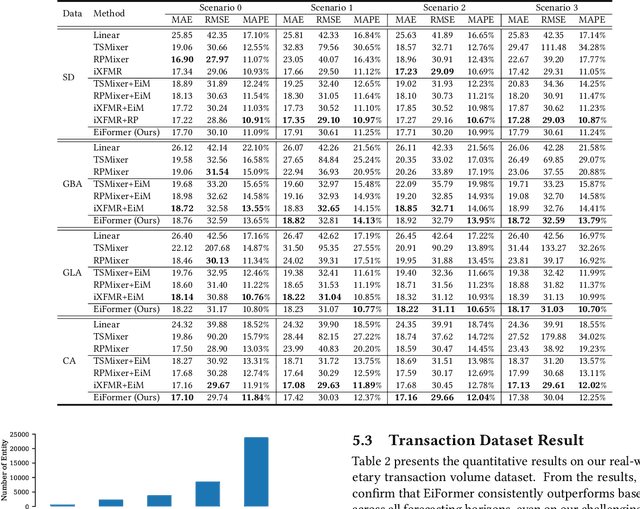

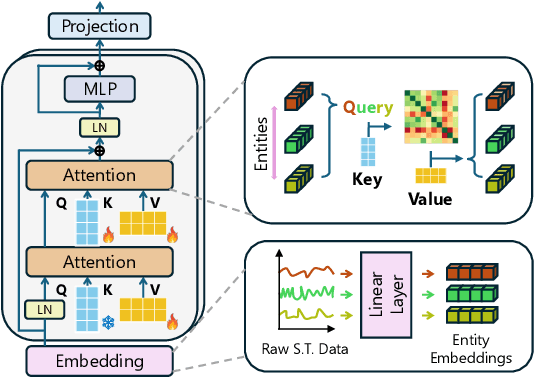
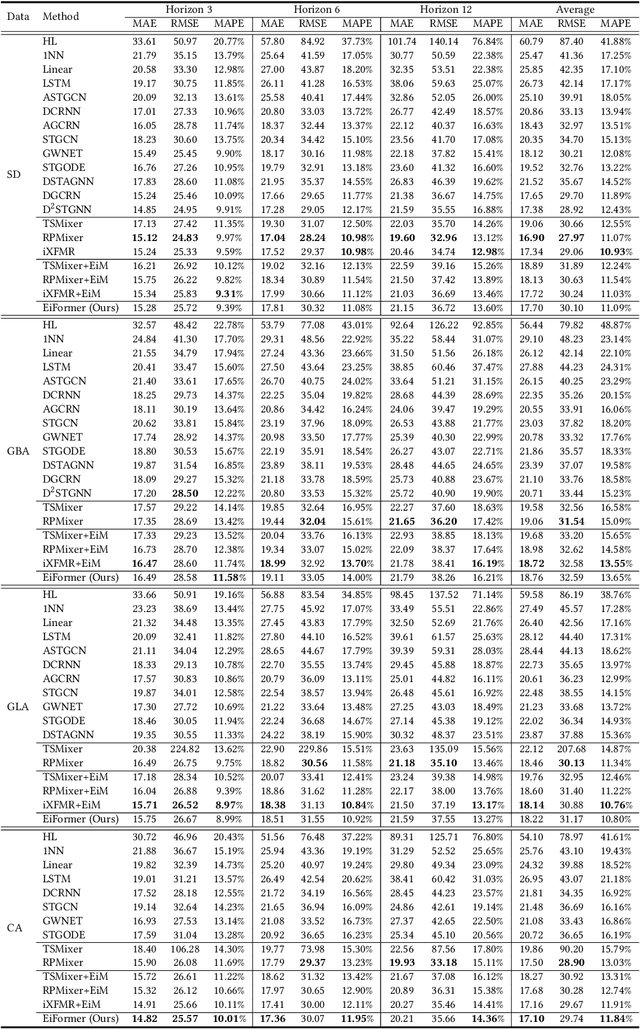
Abstract:Time series forecasting at scale presents significant challenges for modern prediction systems, particularly when dealing with large sets of synchronized series, such as in a global payment network. In such systems, three key challenges must be overcome for accurate and scalable predictions: 1) emergence of new entities, 2) disappearance of existing entities, and 3) the large number of entities present in the data. The recently proposed Inverted Transformer (iTransformer) architecture has shown promising results by effectively handling variable entities. However, its practical application in large-scale settings is limited by quadratic time and space complexity ($O(N^2)$) with respect to the number of entities $N$. In this paper, we introduce EiFormer, an improved inverted transformer architecture that maintains the adaptive capabilities of iTransformer while reducing computational complexity to linear scale ($O(N)$). Our key innovation lies in restructuring the attention mechanism to eliminate redundant computations without sacrificing model expressiveness. Additionally, we incorporate a random projection mechanism that not only enhances efficiency but also improves prediction accuracy through better feature representation. Extensive experiments on the public LargeST benchmark dataset and a proprietary large-scale time series dataset demonstrate that EiFormer significantly outperforms existing methods in both computational efficiency and forecasting accuracy. Our approach enables practical deployment of transformer-based forecasting in industrial applications where handling time series at scale is essential.
MOOSS: Mask-Enhanced Temporal Contrastive Learning for Smooth State Evolution in Visual Reinforcement Learning
Sep 02, 2024



Abstract:In visual Reinforcement Learning (RL), learning from pixel-based observations poses significant challenges on sample efficiency, primarily due to the complexity of extracting informative state representations from high-dimensional data. Previous methods such as contrastive-based approaches have made strides in improving sample efficiency but fall short in modeling the nuanced evolution of states. To address this, we introduce MOOSS, a novel framework that leverages a temporal contrastive objective with the help of graph-based spatial-temporal masking to explicitly model state evolution in visual RL. Specifically, we propose a self-supervised dual-component strategy that integrates (1) a graph construction of pixel-based observations for spatial-temporal masking, coupled with (2) a multi-level contrastive learning mechanism that enriches state representations by emphasizing temporal continuity and change of states. MOOSS advances the understanding of state dynamics by disrupting and learning from spatial-temporal correlations, which facilitates policy learning. Our comprehensive evaluation on multiple continuous and discrete control benchmarks shows that MOOSS outperforms previous state-of-the-art visual RL methods in terms of sample efficiency, demonstrating the effectiveness of our method. Our code is released at https://github.com/jsun57/MOOSS.
Revealing the Power of Spatial-Temporal Masked Autoencoders in Multivariate Time Series Forecasting
Sep 26, 2023Abstract:Multivariate time series (MTS) forecasting involves predicting future time series data based on historical observations. Existing research primarily emphasizes the development of complex spatial-temporal models that capture spatial dependencies and temporal correlations among time series variables explicitly. However, recent advances have been impeded by challenges relating to data scarcity and model robustness. To address these issues, we propose Spatial-Temporal Masked Autoencoders (STMAE), an MTS forecasting framework that leverages masked autoencoders to enhance the performance of spatial-temporal baseline models. STMAE consists of two learning stages. In the pretraining stage, an encoder-decoder architecture is employed. The encoder processes the partially visible MTS data produced by a novel dual-masking strategy, including biased random walk-based spatial masking and patch-based temporal masking. Subsequently, the decoders aim to reconstruct the masked counterparts from both spatial and temporal perspectives. The pretraining stage establishes a challenging pretext task, compelling the encoder to learn robust spatial-temporal patterns. In the fine-tuning stage, the pretrained encoder is retained, and the original decoder from existing spatial-temporal models is appended for forecasting. Extensive experiments are conducted on multiple MTS benchmarks. The promising results demonstrate that integrating STMAE into various spatial-temporal models can largely enhance their MTS forecasting capability.
Towards Globally Consistent Stochastic Human Motion Prediction via Motion Diffusion
May 21, 2023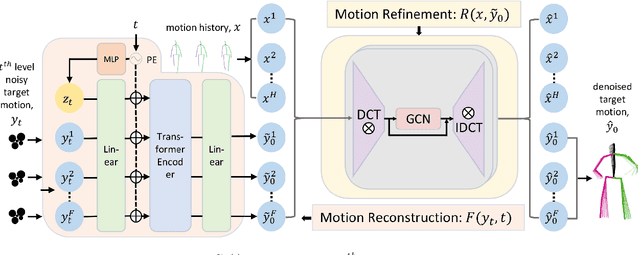
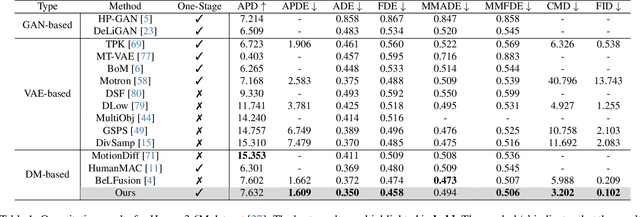
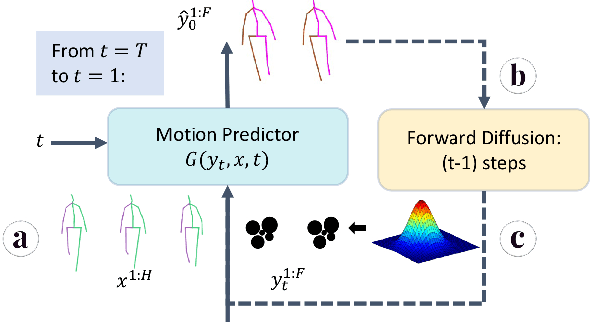

Abstract:Stochastic human motion prediction aims to predict multiple possible upcoming pose sequences based on past human motion trajectories. Prior works focused heavily on generating diverse motion samples, leading to inconsistent, abnormal predictions from the immediate past observations. To address this issue, in this work, we propose DiffMotion, a diffusion-based stochastic human motion prediction framework that considers both the kinematic structure of the human body and the globally temporally consistent nature of motion. Specifically, DiffMotion consists of two modules: 1) a transformer-based network for generating an initial motion reconstruction from corrupted motion, and 2) a multi-stage graph convolutional network to iteratively refine the generated motion based on past observations. Facilitated by the proposed direct target prediction objective and the variance scheduler, our method is capable of predicting accurate, realistic and consistent motion with an appropriate level of diversity. Our results on benchmark datasets demonstrate that DiffMotion outperforms previous methods by large margins in terms of accuracy and fidelity while demonstrating superior robustness.
Towards Accurate Human Motion Prediction via Iterative Refinement
May 08, 2023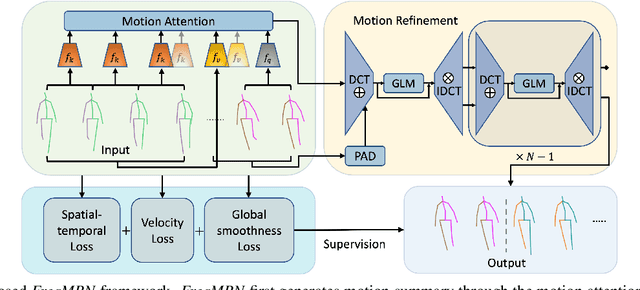
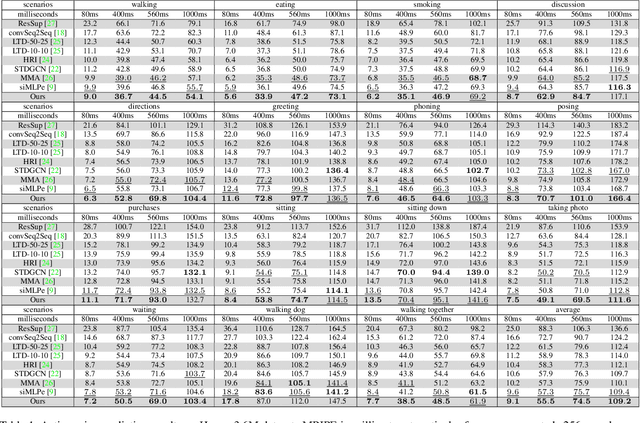
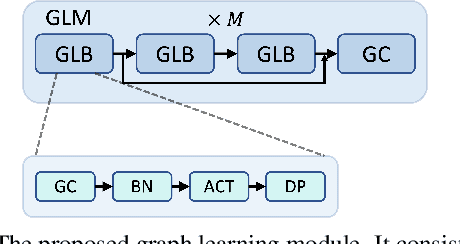

Abstract:Human motion prediction aims to forecast an upcoming pose sequence given a past human motion trajectory. To address the problem, in this work we propose FreqMRN, a human motion prediction framework that takes into account both the kinematic structure of the human body and the temporal smoothness nature of motion. Specifically, FreqMRN first generates a fixed-size motion history summary using a motion attention module, which helps avoid inaccurate motion predictions due to excessively long motion inputs. Then, supervised by the proposed spatial-temporal-aware, velocity-aware and global-smoothness-aware losses, FreqMRN iteratively refines the predicted motion though the proposed motion refinement module, which converts motion representations back and forth between pose space and frequency space. We evaluate FreqMRN on several standard benchmark datasets, including Human3.6M, AMASS and 3DPW. Experimental results demonstrate that FreqMRN outperforms previous methods by large margins for both short-term and long-term predictions, while demonstrating superior robustness.
Dynamic Graph Node Classification via Time Augmentation
Dec 07, 2022



Abstract:Node classification for graph-structured data aims to classify nodes whose labels are unknown. While studies on static graphs are prevalent, few studies have focused on dynamic graph node classification. Node classification on dynamic graphs is challenging for two reasons. First, the model needs to capture both structural and temporal information, particularly on dynamic graphs with a long history and require large receptive fields. Second, model scalability becomes a significant concern as the size of the dynamic graph increases. To address these problems, we propose the Time Augmented Dynamic Graph Neural Network (TADGNN) framework. TADGNN consists of two modules: 1) a time augmentation module that captures the temporal evolution of nodes across time structurally, creating a time-augmented spatio-temporal graph, and 2) an information propagation module that learns the dynamic representations for each node across time using the constructed time-augmented graph. We perform node classification experiments on four dynamic graph benchmarks. Experimental results demonstrate that TADGNN framework outperforms several static and dynamic state-of-the-art (SOTA) GNN models while demonstrating superior scalability. We also conduct theoretical and empirical analyses to validate the efficiency of the proposed method. Our code is available at https://sites.google.com/view/tadgnn.
Elastica: A compliant mechanics environment for soft robotic control
Sep 17, 2020
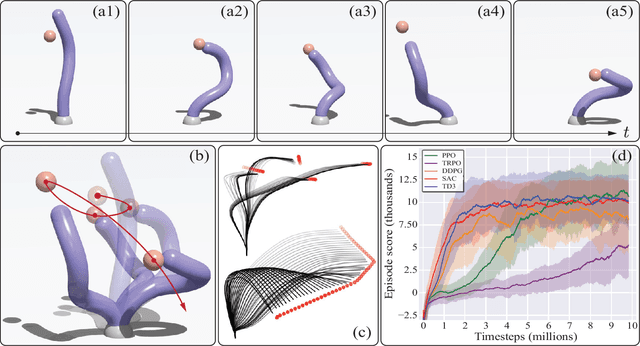
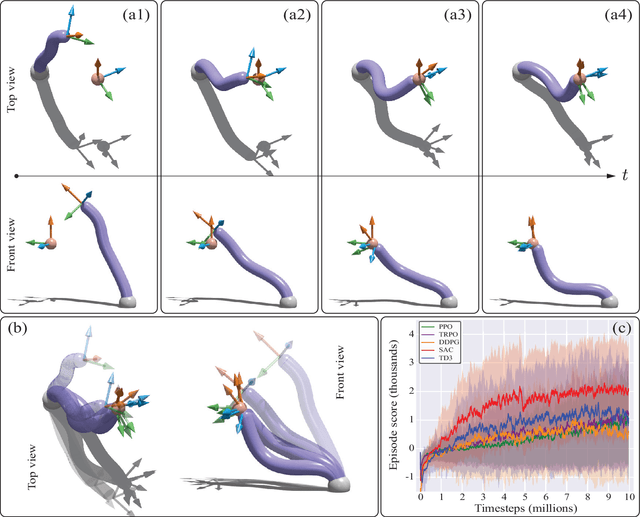
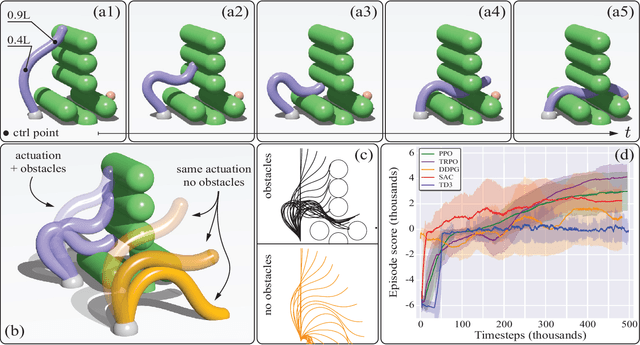
Abstract:Soft robots are notoriously hard to control. This is partly due to the scarcity of models able to capture their complex continuum mechanics, resulting in a lack of control methodologies that take full advantage of body compliance. Currently available simulation methods are either too computational demanding or overly simplistic in their physical assumptions, leading to a paucity of available simulation resources for developing such control schemes. To address this, we introduce Elastica, a free, open-source simulation environment for soft, slender rods that can bend, twist, shear and stretch. We demonstrate how Elastica can be coupled with five state-of-the-art reinforcement learning algorithms to successfully control a soft, compliant robotic arm and complete increasingly challenging tasks.
Globally Variance-Constrained Sparse Representation and Its Application in Image Set Coding
May 03, 2018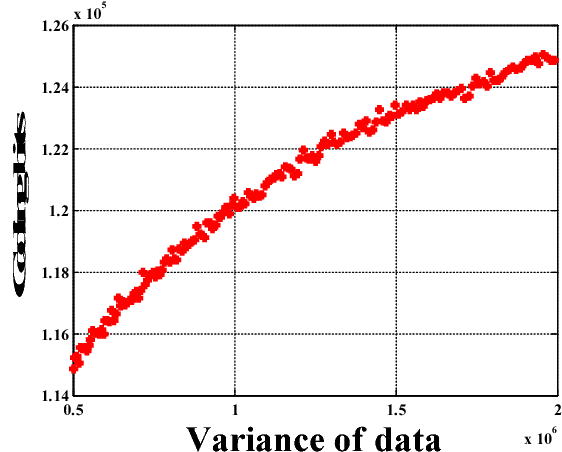
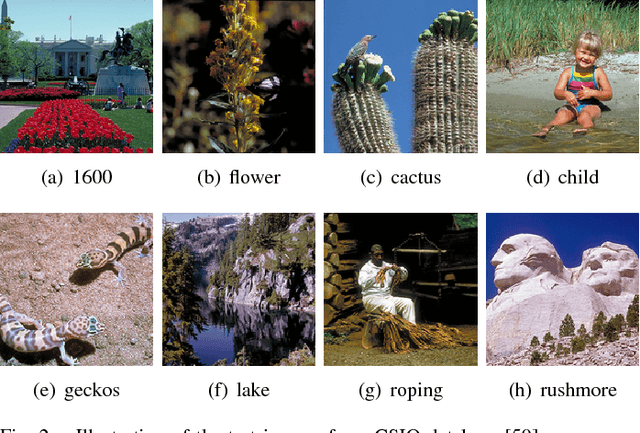
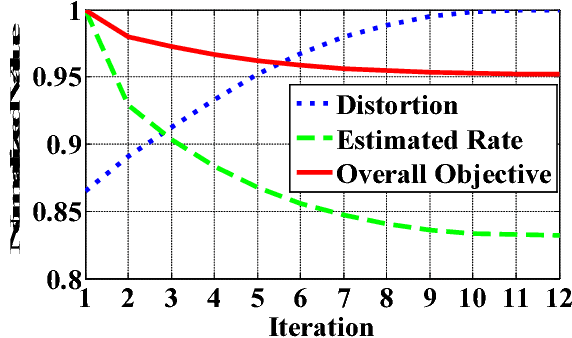
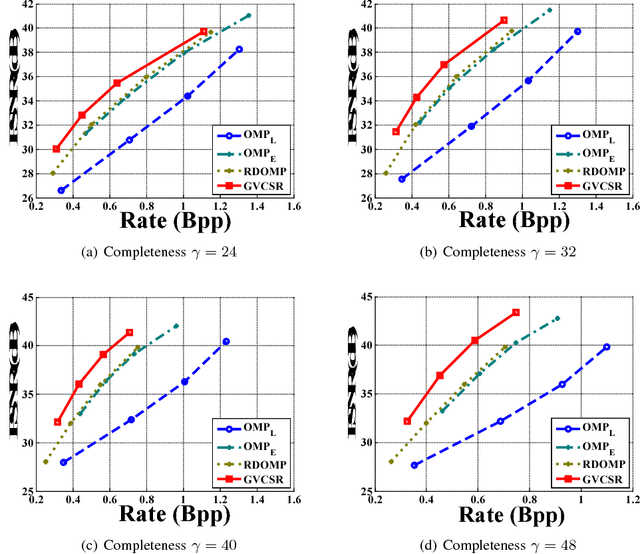
Abstract:Sparse representation leads to an efficient way to approximately recover a signal by the linear composition of a few bases from a learnt dictionary, based on which various successful applications have been achieved. However, in the scenario of data compression, its efficiency and popularity are hindered. It is because of the fact that encoding sparsely distributed coefficients may consume more bits for representing the index of nonzero coefficients. Therefore, introducing an accurate rate-constraint in sparse coding and dictionary learning becomes meaningful, which has not been fully exploited in the context of sparse representation. According to the Shannon entropy inequality, the variance of a Gaussian distributed data bounds its entropy, indicating the actual bitrate can be well estimated by its variance. Hence, a Globally Variance-Constrained Sparse Representation (GVCSR) model is proposed in this work, where a variance-constrained rate term is introduced to the optimization process. Specifically, we employ the Alternating Direction Method of Multipliers (ADMM) to solve the non-convex optimization problem for sparse coding and dictionary learning, both of them have shown the state-of-the-art rate-distortion performance for image representation. Furthermore, we investigate the potential of applying the GVCSR algorithm in the practical image set compression, where the optimized dictionary is trained to efficiently represent the images captured in similar scenarios by implicitly utilizing inter-image correlations. Experimental results have demonstrated superior rate-distortion performance against the state-of-the-art methods.
 Add to Chrome
Add to Chrome Add to Firefox
Add to Firefox Add to Edge
Add to Edge